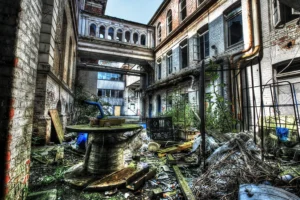
Abandoned sites, often shrouded in mystery and intrigue, offer a captivating glimpse into the past. From crumbling factories to forgotten asylums, these sites tell stories of bygone eras, forgotten lives, and the relentless march of time. This article explores the allure of abandoned sites, revealing the rich histories and secrets hidden within their decaying walls. We will delve into the reasons behind their abandonment, the historical significance of these locations, and what makes them so intriguing to modern explorers.
The Fascination with Abandoned Sites
Abandoned sites captivate the imagination for several reasons. They evoke a sense of nostalgia and curiosity about what once was. The contrast between their past grandeur and present decay creates a powerful visual impact, stirring emotions and prompting reflections on impermanence and change.
- Historical Significance: Many abandoned sites were once hubs of activity and innovation. For instance, old factories and mills played crucial roles in industrial revolutions, while abandoned hospitals and asylums tell tales of medical advancements and social changes. Understanding these sites requires piecing together historical context and appreciating their roles in shaping our modern world.
- Architectural Intrigue: The architecture of abandoned sites often reflects the styles and technologies of their time. From Gothic Revival asylums to Art Deco cinemas, the design and craftsmanship of these structures can offer insights into past architectural trends and societal values.
- Personal Stories: Abandoned sites hold the remnants of personal histories. The graffiti on the walls, personal belongings left behind, and faded photographs provide a tangible connection to the people who once inhabited these spaces. Exploring these elements can reveal stories of triumph, struggle, and everyday life.
Reasons Behind Abandonment
Several factors contribute to the abandonment of sites. Understanding these reasons provides a clearer picture of their histories and the circumstances that led to their decline.
- Economic Shifts: Economic downturns and shifts in industry can lead to the closure of factories, offices, and other commercial establishments. As industries evolve or relocate, buildings that were once central to economic activity are left behind.
- Technological Advances: Technological progress can render facilities obsolete. For instance, older manufacturing plants might be replaced by more modern facilities equipped with advanced machinery, leading to the abandonment of the former.
- Urban Development: As cities expand and evolve, older structures may be demolished to make way for new developments. This process can lead to the abandonment of historic buildings and landmarks.
- Social Changes: Shifts in societal attitudes and policies can also contribute to the abandonment of sites. Changes in healthcare practices, for example, have led to the closure of many mental institutions and hospitals.
Exploring Abandoned Sites: What to Expect
Visiting abandoned sites requires careful consideration and respect for the locations. Here are some common features and experiences:
- Decay and Nature’s Reclamation: Abandoned sites are often in various states of decay, with nature gradually reclaiming the space. Overgrown vegetation, peeling paint, and structural damage are common sights, offering a poignant reminder of the passage of time.
- Historical Artifacts: Inside abandoned sites, you may encounter remnants of their former use. This can include old machinery, furniture, documents, and personal items. These artifacts offer valuable clues about the site’s history and the people who once worked or lived there.
- Graffiti and Artwork: Many abandoned sites are adorned with graffiti and street art. While often viewed as vandalism, this artwork can also provide insight into contemporary culture and the ways in which modern artists engage with these spaces.
- Sense of Mystery: The desolation and eerie silence of abandoned sites contribute to a sense of mystery and intrigue. Exploring these places often feels like stepping into a time capsule, where the past and present collide in hauntingly beautiful ways.
The Ethics of Exploring Abandoned Sites
While exploring abandoned sites can be fascinating, it is essential to approach these locations ethically and responsibly. Here are some guidelines:
- Respect Private Property: Many abandoned sites are privately owned. Gaining permission before entering is crucial to avoid legal issues and respect the rights of property owners.
- Prioritize Safety: Abandoned buildings can be hazardous due to unstable structures, sharp objects, and environmental contaminants. Proper safety precautions, such as wearing protective clothing and bringing a companion, are essential.
- Preserve and Protect: Avoid vandalism and theft. The goal is to appreciate and document the history without causing harm. Leave the site as you found it to ensure its preservation for future generations.
- Follow Local Regulations: Be aware of and adhere to local laws and regulations regarding the exploration of abandoned sites. Some areas may have specific rules or restrictions in place to protect both the sites and visitors.
Conclusion
Abandoned sites are windows into the past, offering rich and mysterious histories that captivate and inspire. Whether through their historical significance, architectural intrigue, or the personal stories they hold, these locations provide valuable insights into previous eras. By approaching these explorations with respect and caution, we can continue to uncover and appreciate the secrets hidden within these forgotten spaces. Each abandoned site tells a unique story, contributing to our understanding of history and the passage of time.




